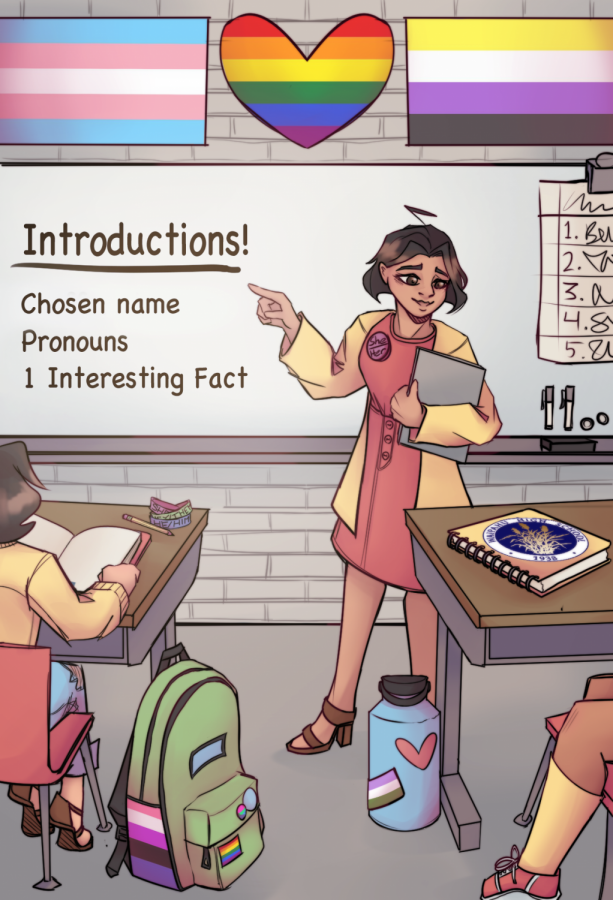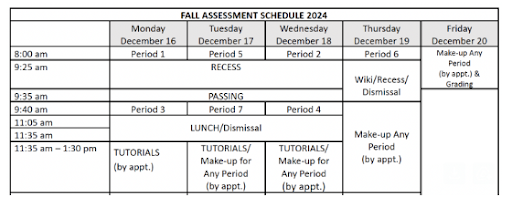Teachers develop inclusive classrooms for LGBTQ+ students
A note on the use of the word “queer” from the Associated Press Stylebook: “Queer” is an umbrella term covering people who are not heterosexual or cisgender and is acceptable for people and organizations that use the term to identify themselves. It should not be used as a slur.
Throughout the school year, teachers have taken action to promote inclusivity and awareness towards LGBTQ+ identities and topics in the classroom. Teachers have acknowledged queer students in beginning of the year activities and lessons, giving students opportunities to communicate about themselves and learn more about queer identities. These small changes have allowed queer students to express their identities and be respected in school.
Teachers have mainly altered activities in the beginning of the year, where they most often learn about their students. They allow questions and environment to focus less on the gender binary. Students using chosen names and pronouns rather than those assigned at birth are given ways to communicate those differences. Teachers may ask for student names and pronouns to avoid inaccuracies. With creative a approach to this subject, Waipahu High School teacher Thelma Madriaga begins the year with a nameplate activity that lets students pick from blue, pink, and purple colored nameplates. Her students accordingly indicate what they are comfortable with being called.
Outside of the classroom, Katheryne Huihui, the Love Is Found Everywhere (LIFE) Club advisor, brings up gender-inclusive topics that faculty and staff are discussing more often.
Huihui says, “I’ve also had discussions with other teachers about dead names, especially because we were virtually learning last year.”
“Another thing is just bringing up the topic a lot more about gender neutral bathrooms,” Huihui says. “It’s been definitely something on faculty’s mind, just trying to be more inclusive of students who identify as not their assigned sex at birth, but their preferred gender identity and sexuality.” Some accommodations Huihui is aware of include updated student IDs and email addresses, allowing students’ chosen names to be reflected in their identification.
Creating change towards a topic that has a large significance in student lives takes time, and small efforts have positive impacts on student lives. Learning about a person’s identity and referring to them in a way that affirms that can be a large adjustment to make. One recommended mindset is making efforts to learn and adapt with genuine intentions. As Madriaga elaborates, “It’s most important that I know my students know that I come from a place of positive intention and not of judgement intentions.”
Queer students have appreciated these accommodations, and expressed ways these changes positively affect their experience at WHS. As two L.I.F.E. Club members express, “I believe queer students feel more accepted and comfortable with this acceptance. Acceptance, praise, and comfort from others are human needs. These needs being fulfilled can be change people’s lives”, and, “More acceptance has allowed us [queer students] to not be ashamed of who we are.”
Kai Valle (’25) adds that queer students are “more eager to come to school, do better in school. Just really minor things like that, that pile on and make something really, really big.” Valle says that being respected “makes me more comfortable with working. I focus better if I’m not, I guess, being judged.”
Having a support system to rely on when considering these topics is important. We rely on L.I.F.E. Club and our advisor, trusted community members, reliable online resources, and resources provided by the school. It’s essential for resources become more accessible to students and that they will have options available to reach out to others and start meaningful conversations.
If a person wants to be part of that support system for a queer student who has shared their identity and isn’t sure of where to start, there are many ideas to keep in mind while learning more about their peer:
“Make sure they know that with you, they’re safe and accepted for who they are. If other people in their life don’t support them, I would try to help in any way possible, like talking to their parents, or giving them resources to learn and educate themselves on having a queer child.”
“Accept them for who they are. Change how you think of them, for example, transition any old assumptions you have had to what they came out to you as. Listen without judgement or unwanted input.”
Huihui adds, “All of us have, at some point in time, questioned who we are, what we believe in and how we represent our identity and people should just be understanding […] Tell them you’re proud of them, but don’t draw attention to it in ways that they will not feel comfortable with.”
When a person is questioning themselves, it can be hard to find advice when they’re not sure who to trust about that information. From personal experience, L.I.F.E. Club offers their advice for those exploring their identities:
“Don’t adhere to labels, be who you are. If you want a label, don’t rush into it. There’s so many different identities and sexualities out there that it might take a minute for you to figure out who you are. No matter what happens, just know that you are valid and loved.”
“There is no need to to put a specific label on it [your identity]. We say ‘love is love’ for a reason,” and, “Try [a new identity] out, and if it doesn’t fit, that is still progress to finding something fitting.”
“You existing isn’t a crime or something you have to apologize for. Being comfortable in your own skin isn’t something you have to deserve. You shouldn’t be mocked or scoffed at for expressing emotions.”

Hello, my name is Jolene Palijo, and I’m this year’s Editor-In-Chief for The Cane Tassel! I am a senior in the Academy of Professional and Public Services,...






